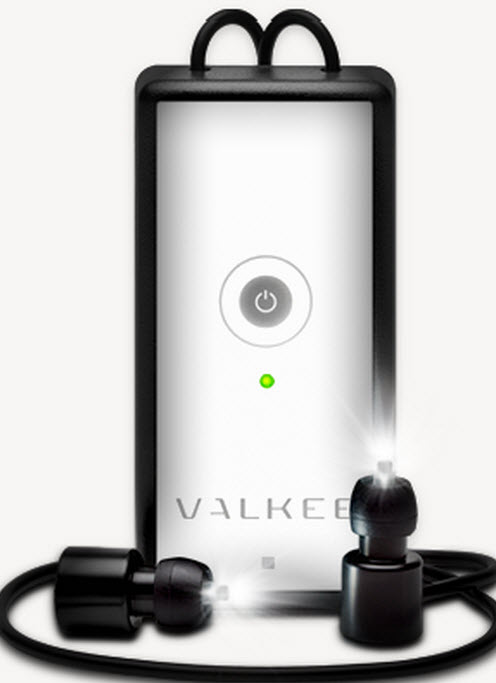How to stimulate your brain by shining light through your ears
August 15, 2011 by Amara D. Angelica

Light stimulus setup (left) -- no evidence that Anthony Hopkins was involved in the design -- and ear-canal position (right) (credit: T. Starck et al.)
Ever want to just like, lie down and shine bright white light at the intensity of the Sun into your ears to see if that will wake you up from your deep depression? Me neither.
But Finnish people are apparently desperate. Especially in Winter, when they get as little as four to six hours of Sun a day. So neuroscientists at the University of Oulu in Finland and Valkee decided what the hell, let’s try it. Their hypothesis was that it would stimulate photosensitive regions of the brain — and perhaps deal with SAD (seasonal affective disorder).
They actually got the idea from their previous study of human brain tissue (on criminals designated for autopsy — again, no connection with lambs was stated), which found potentially light-sensitive OPN3 opsin proteins in 18 areas outside the visual system.

Valkee NPT-1000 bright-light headset (credit: Valkee Ltd)
How light affects the brain directly
So they used fMRI analysis (detecting blood flow in the brain) and discovered increased activity and “gradual increase in functional connectivity” in several areas of the brain after shining light into the ears, including the cerebral cortex and also phylogenetically old regions.
A few subjects also described clearer sight and widened view of sight at some time after the light stimulus. (Gives new meaning to Debbie Boones’ “You light up my life.”)
“Brain regions encountering most of the light are probably anterior cerebellum, brainstem and inferior temporal cortex, also posterior diencephalon and anterior occipital lobe,” they said. (Note in the MRI images that the path of the light is to those areas.) These are brain areas that produce and store neurotransmitters like serotonin and melatonin, which play key roles in mood, sleep and depression.
“Hypothetical site for phototransduction could be cerebellarPurkinje cells that are rich of panopsinin rats. Also, brainstem nuclei related to neurotransmitters like dopamine, serotonin or noradrenaline may be directly or indirectly involved in the photoreception.”
Treating those mood swings
Based on the research an affiliated company, Valkee, has come out with a “bright-light headset” that “prevents and treat mood swings and circadian rhythm disorders and increases energy,” the company claims. Unfortunately, no specific research to back up those claims is cited on their website, so I’ve requested more info.
One thing I’d also like to know: is there a way to control which neurotransmitter is activated? For example, I’d want to avoid stimulating melatonin when trying to wake up. What about treatment of bipolar disorder? Also, is there a way to add sound so I could hear my favorite music during a treatment session? And should I block my ears from light before going to sleep or do the opposite: hold my head up to my desk lamp and hope no one is watching? Help me out here.
Meanwhile, people living below 64 degrees latitude N (and above 64 degrees S) who prefer RL (real life) might want to try actual sunlight (what a concept) — like an afternoon at the beach.
Ref.: T. Starck, et al., Stimulating brain tissue with bright light — resting state fMRI analysis, Scandinavian Physiology Society Annual Meeting 2011; [link]